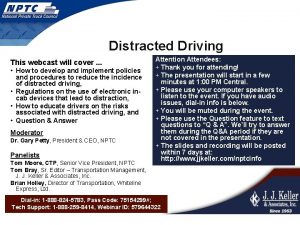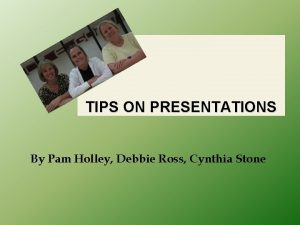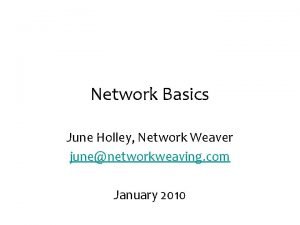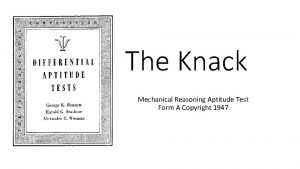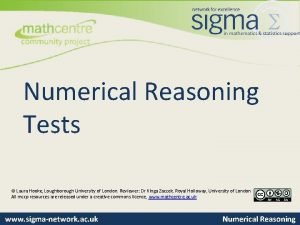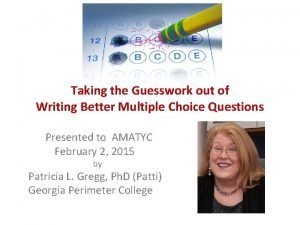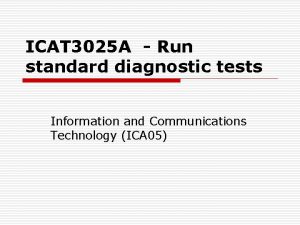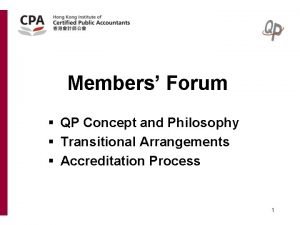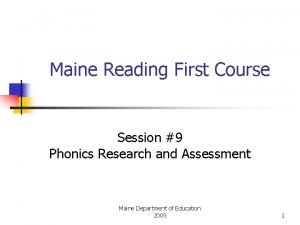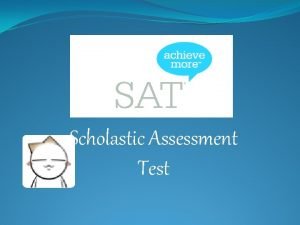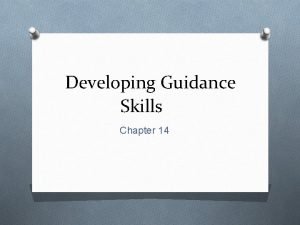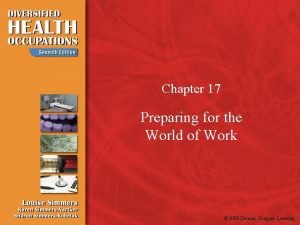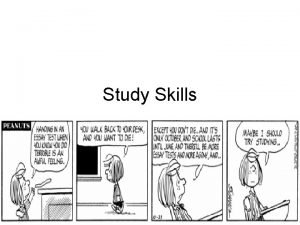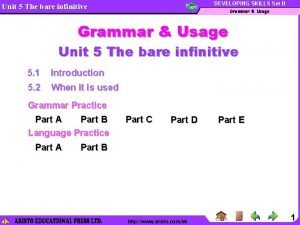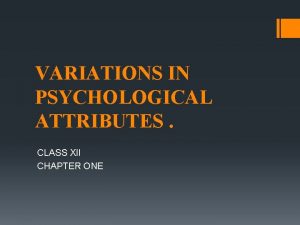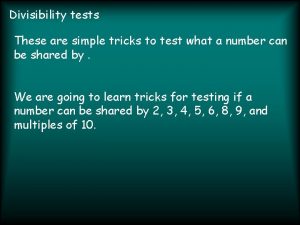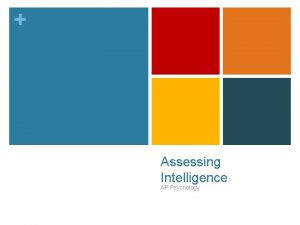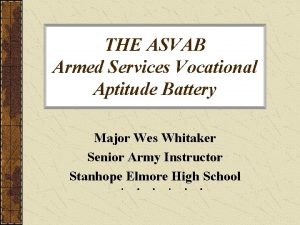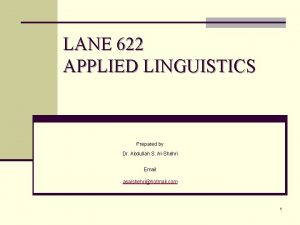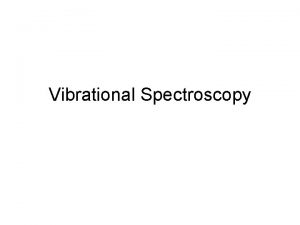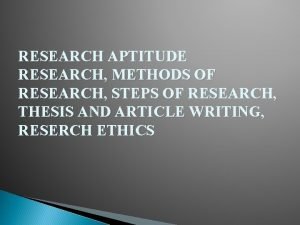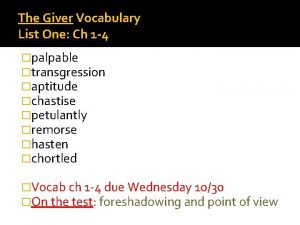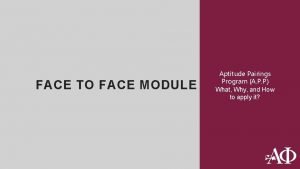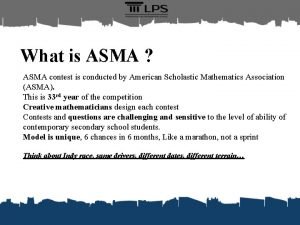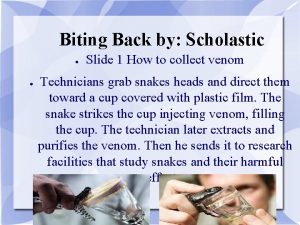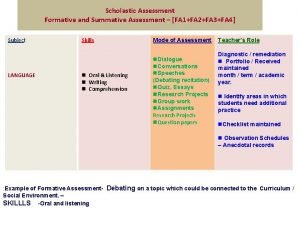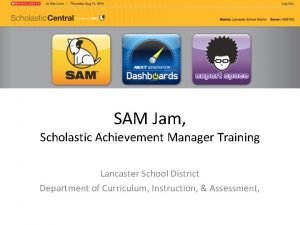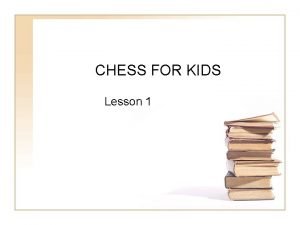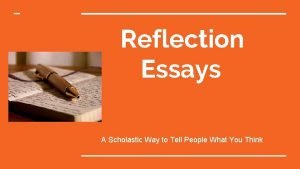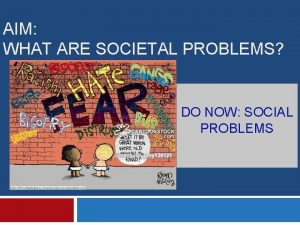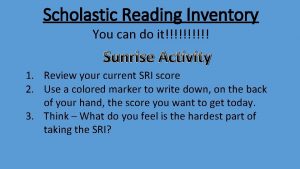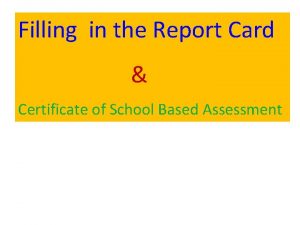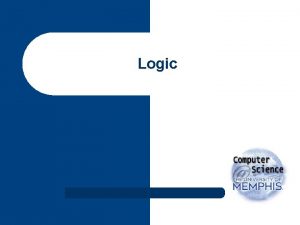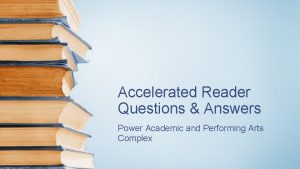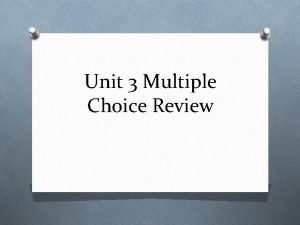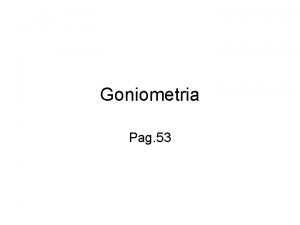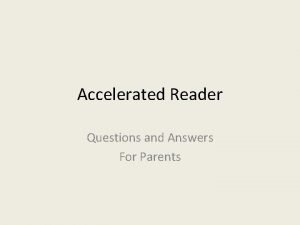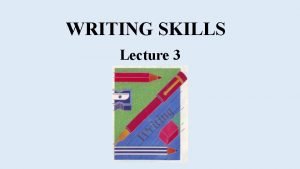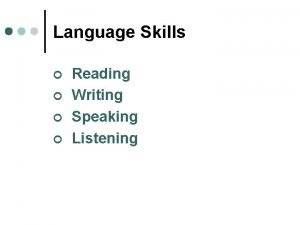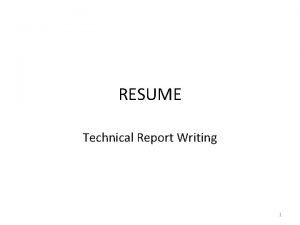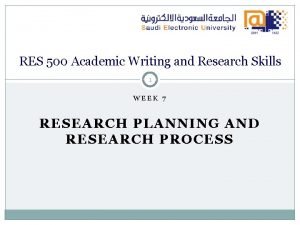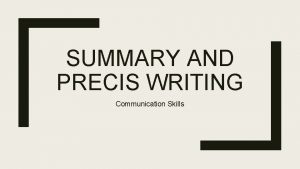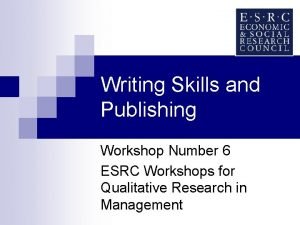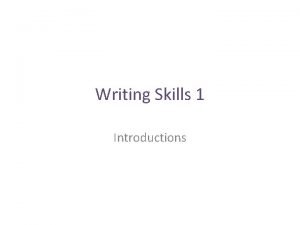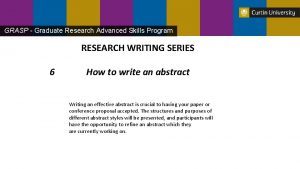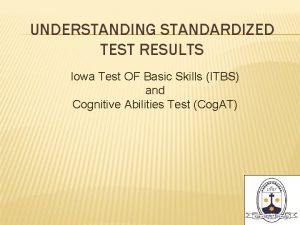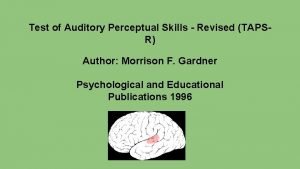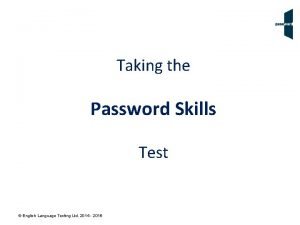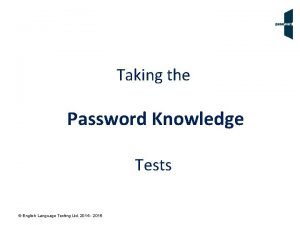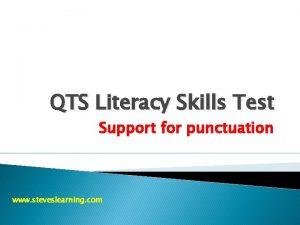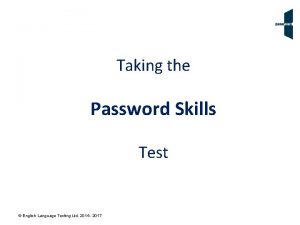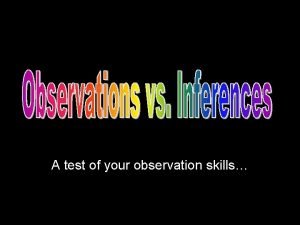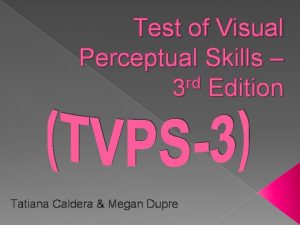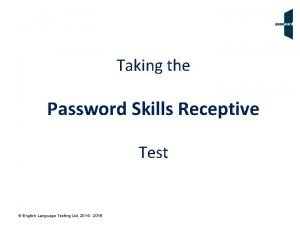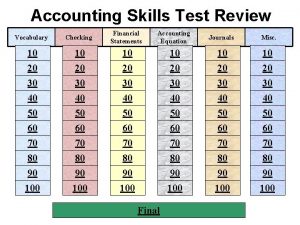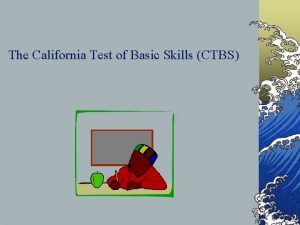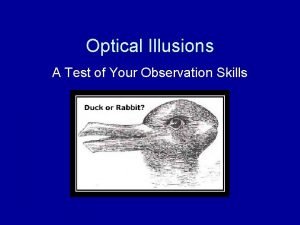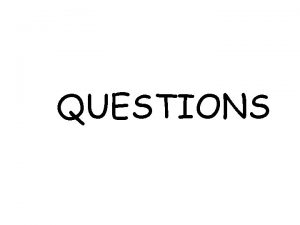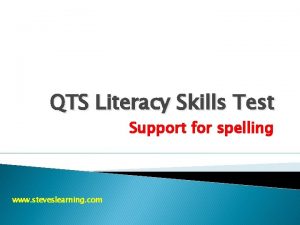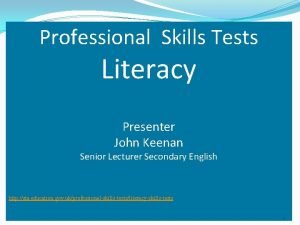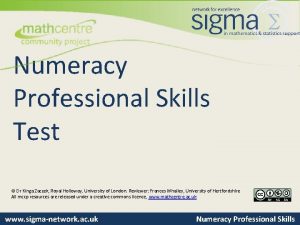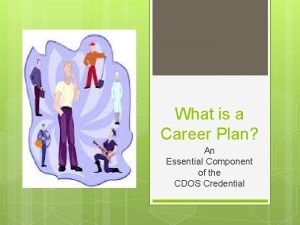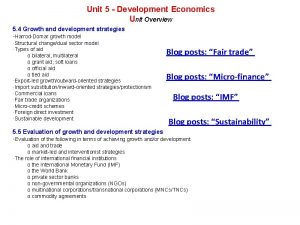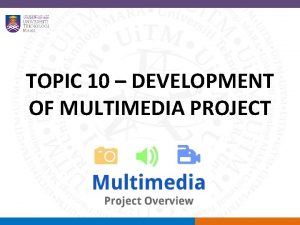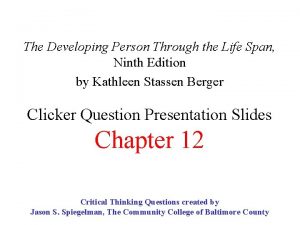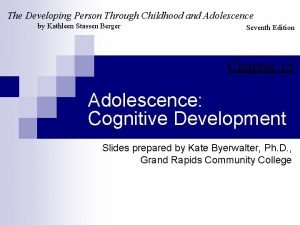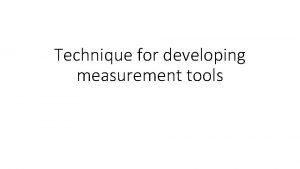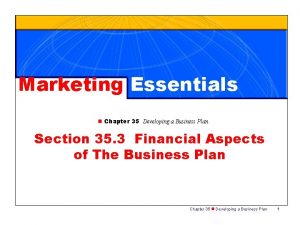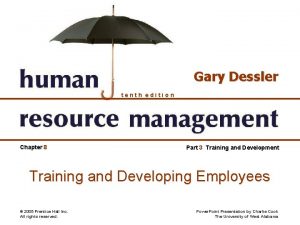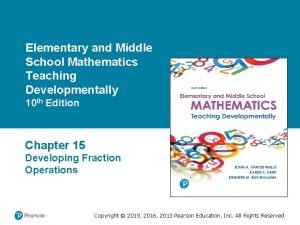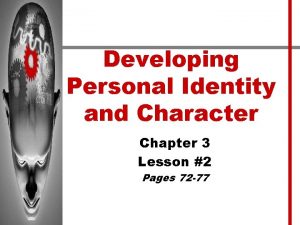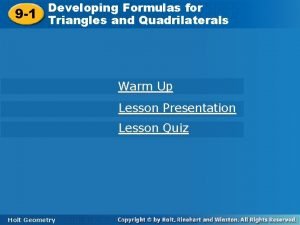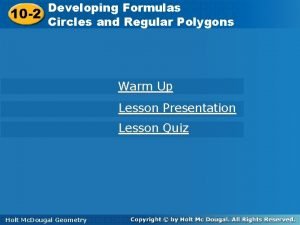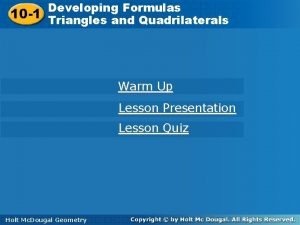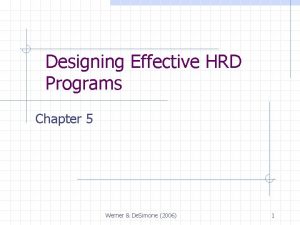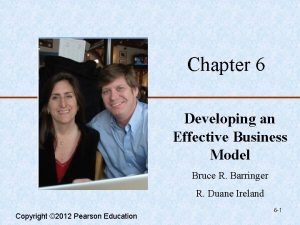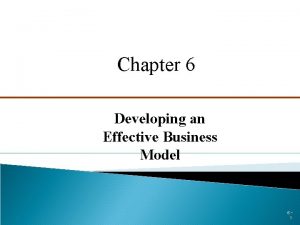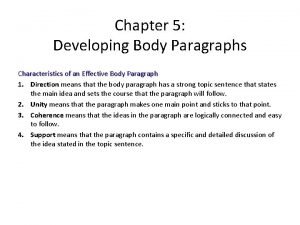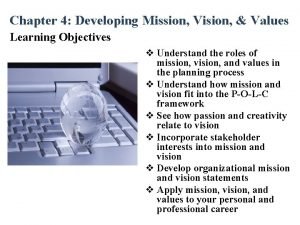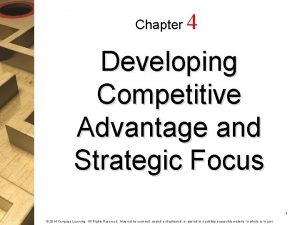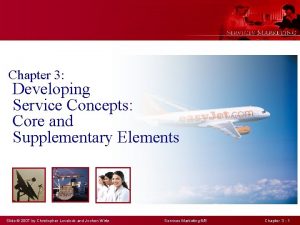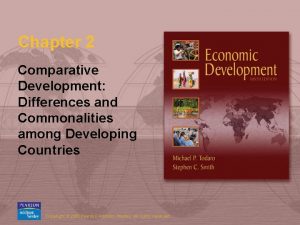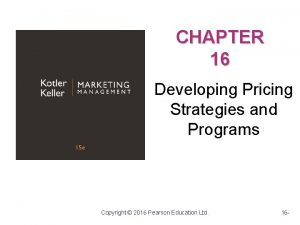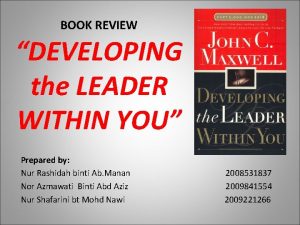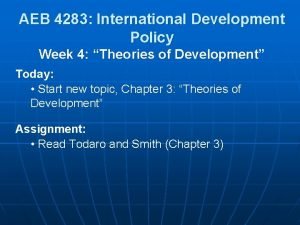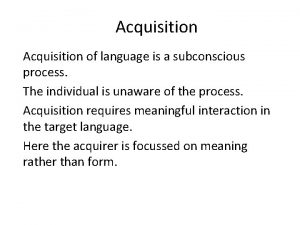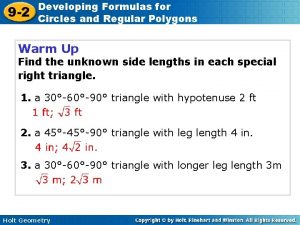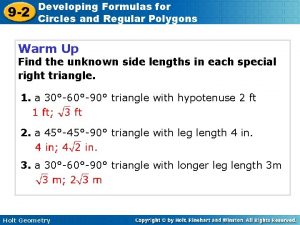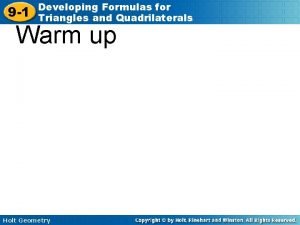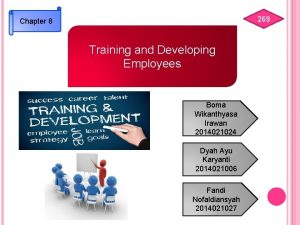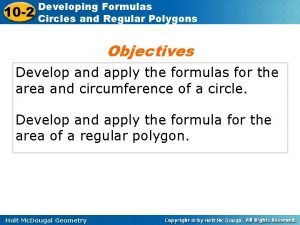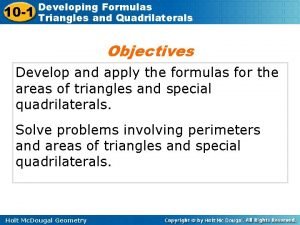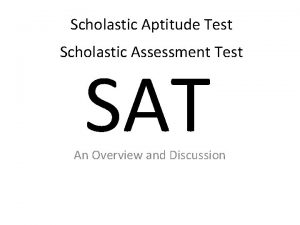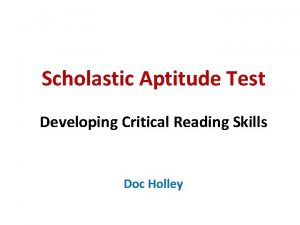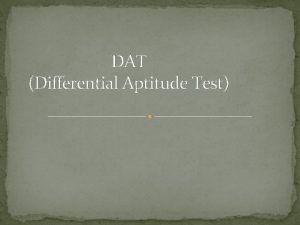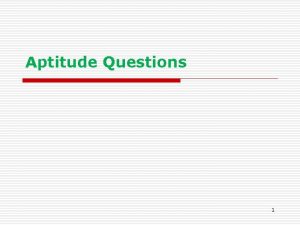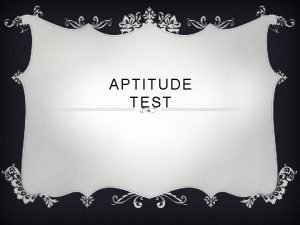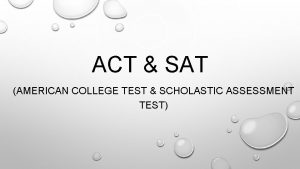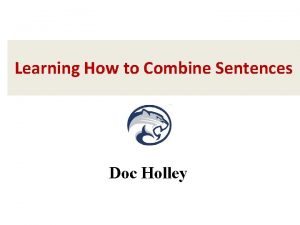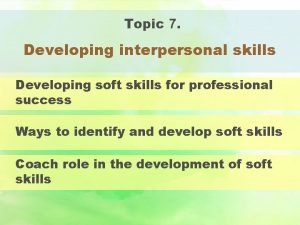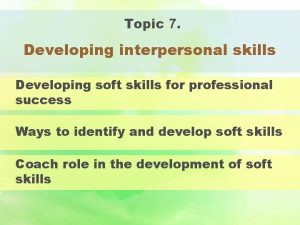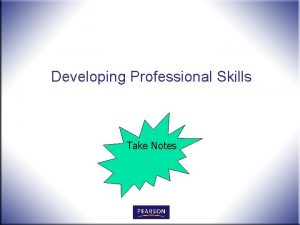Scholastic Aptitude Test Developing Writing Skills Doc Holley



























































































































































- Slides: 155

Scholastic Aptitude Test Developing Writing Skills Doc Holley

S. A. T. Writing Section Facts Question types # of Questions Time Essay 1 25 minutes Multiple-choice 49 35 minutes (one 25 minute section and one 10 -minute section) Total: 50 60 minutes

The Essay • The essay is always the first question on the SAT. Students are given 25 minutes to respond to the question by writing an essay in longhand on the answer sheet, using a No. 2 pencil. The essay measures a student's ability to: • Develop a point of view on an issue presented in an excerpt • Support a point of view using reasoning and examples from their reading, studies, experience, or observations • Follow the conventions of Standard Written English • Students are given a prompt or assignment, which is a short (no more than 80 words long) quotation or statement on an issue that is carefully selected to: • Enable students to react and respond quickly in a variety of ways • Be easily accessible to the general test-taking population, including students for whom English is a second language (ESL) • Be free of figurative, technical, or specific literary references

THE ESSAY • Need to show effectively you can develop and express ideas – Take care to develop your point of view, present your ideas logically and clearly, and use language precisely • Must be written on the lines provided in the answer book • Avoid wide margins and keep your handwriting to a reasonable size • Write or print so that the writing is legible to scorers • Must use a pencil – • An off-topic essay will receive a score of zero • If your essay does not reflect your original and individual work, your test scores may be canceled

Tackling the Essay • Decide if you agree or disagree with the essay prompt and write your thesis. • Take 5 minutes to outline your essay response. • Essay should consist of 5 paragraphs – An introduction – One paragraph each detailing 3 different examples that support your thesis – A conclusion • Try to use one example from literature/history/current events and your own personal experience Make sure you allow time for proofreading. The Essay counts 30% of your total score in the writing section.

THE ESSAY – sample prompt • Prompt 1 • Think carefully about the issue presented in the following excerpt and the assignment below. • Most people think that contentment—being happy with the way things are—is the perfect state of affairs. After all, what could be better than being so satisfied with how things are that you don't want anything else? But contentment has disadvantages: if we are content with the way things are, we are not motivated to change things, to improve ourselves, or to do better. We must therefore always choose between being content and pushing ourselves to do better. • Assignment: Does being content with the way things are prevent people from improving themselves and doing better? Plan and write an essay in which you develop your point of view on this issue. Support your position with reasoning and examples taken from your reading, studies, experience, or observations.

THE ESSAY – sample prompt • Prompt 2 • Think carefully about the issue presented in the following excerpt and the assignment below. • Privacy was once valued and protected. Diaries came with locks to keep the writer’s privately recorded thoughts from being read by others. Public telephones were enclosed in booths so that conversations would not be overheard. But now people feel free to post information about themselves on social networking Web sites and carry on cell phone conversations in public places. We would be much better off if we valued privacy—our own and that of others—far more highly than we do. • Assignment: Do we place too little value on privacy? Plan and write an essay in which you develop your point of view on this issue. Support your position with reasoning and examples taken from your reading, studies, experience, or observations.

THE ESSAY – sample prompt • Prompt 3 • Think carefully about the issue presented in the following excerpt and the assignment below. • Nobody wants to be called old-fashioned or be considered out of touch with current trends and thinking. But there's something to be said for holding on to old ideas and customs even if they may not be in fashion at the moment. People are too easily impressed by anything new and trendy—the latest television show, or music group, or technological gadget. They place too much emphasis on newness without bothering to look at something's real value. • Assignment: Do people place too much value on newness? Plan and write an essay in which you develop your point of view on this issue. Support your position with reasoning and examples taken from your reading, studies, experience, or observations.

THE ESSAY – sample prompt • Prompt 4 • Think carefully about the issue presented in the following excerpt and the assignment below. • Everything a public figure or celebrity says or does is likely to turn up on an internet site or a television show. The great appeal of these sites and shows is that they help us learn as much as possible about public figures. The more we know about political candidates, for example, the more informed we are as voters. Much of the information, however, is irrelevant and actually prevents us from focusing on the issues that matter. • Assignment: Does having too much information about public figures distract us from the important issues? Plan and write an essay in which you develop your point of view on this issue. Support your position with reasoning and examples taken from your reading, studies, experience, or observations.

Multiple-choice Writing Questions The multiple-choice questions assess students' ability to: Communicate ideas clearly and effectively Improve a piece of writing through revision and editing Recognize and identify sentence-level errors Understand grammatical elements and structures and how they relate to each other in a sentence • Recognize correctly formed grammatical structures • Clearly express ideas through sentence-combining and use of transitional words and phrases • Improve coherence of ideas within and among paragraphs • •

Mastering “The Big 3” Writing Skills Improving Sentences (25 questions) Identifying Sentence Errors (18 questions) Improving Paragraphs (6 questions)

Improving Sentences Each Improving Sentence question provides a sentence and asks to you to change the underlined portion if necessary. Once in a while, the underlined portion may include the whole sentence, but usually only a part of the sentence is underlined.

Improving Sentences • This type of question presents a sentence in which part, or all, of the sentence is underlined, followed by five choices of phrasing to replace the underlined section. • The questions assess the ability to: – Recognize and correct faults in grammar and sentence structure – Recognize effective sentences that follow the conventions of Standard Written English

Answer choice (A) is always ‘no error’. Answer choice (A) simply repeats the underlined portion of the sentence as it appears in the question prompt. If there is no error in the sentence, (A) is the correct answer.

Improving Sentences Tips 1 Improving Sentence questions appear in order of difficulty. The easiest questions appear at the beginning of the section and become progressively harder as the section moves along.

Improving Sentences Tips 2 Read the sentence carefully and try to figure out what the issue is before looking at the answers. When you know what improvement to look for, you can often eliminate incorrect answers with just a single word. Rewrite the sentence in your head the way you think it should appear and then look for your rewrite in the answers.

Improving Sentences Tips 3 Start with the shortest answer first and work toward the longest. Correct answers tend to be shorter.

Improving Sentences Tips 4 Watch out for extra pronouns (it, they, that, this, etc. ) and strange uses of the verb ‘to be’ (being, had been, were being, etc. ). These are usually sure signs of an INCORRECT answer.

Improving Sentences Tips 5 Trust your gut. The best sounding answer is usually the right one. Especially among the easier questions at the beginning of the section, choose the answer that you would most likely use if you were writing the sentence.

Improving Sentences Tips 6 Don’t be afraid to pick (A). Statistically, each answer choice appears approximately the same number of times (one out of five). So there will almost always be a number of Sentence Improvement questions where (A) is the correct answer.

Run-On Sentences Since the only thing you need to know about Run-On Sentences on the SAT is that you can’t tie two independent clauses (translation: an independent clause could stand alone as a sentence) together with only a comma, you might sometimes see these called “comma splices. ” There are basically 3 ways to fix them!

Fix Run-On Sentences # 1 Conjunctions. And, but, or, nor, yet, so, for. NOT therefore, however, or because. – Bad: I went to the beach yesterday, Peter came with me. – Fixed: I went to the beach yesterday, and Peter came with me.

Fix Run-On Sentences # 2 Semicolon ( ; ) Unlike a comma, a semicolon requires an independent clause on both sides to be grammatically correct. – Bad: I went to the beach yesterday, the water was freezing. – Fixed: I went to the beach yesterday; the water was freezing.

Fix Run-On Sentences # 3 Make a clause dependent. If neither of these are an option, you might just have to change the wording of whatever part of the sentence is underlined in order to fix a run-on. – Bad: I went to the beach yesterday, a lifeguard punched a shark in the nose! – Fixed: At the beach yesterday, a lifeguard punched a shark in the nose!

Dangling Modifiers A modifier begins a sentence by describing the subject without naming it, and ends with a comma. It will often (but not always) contain an “-ed” or “-ing” word. Basically, if the thing being described in the modifier doesn’t follow directly after the comma, the modifier is left “dangling, ” and that’s grammatically unsound. You have to fix it.

Fix Dangling Modifiers # 1 • Bad: Because he had bet on the race, the horse disappointed Mr. Johnson a great deal. • Fixed: Because he had bet on the race, Mr. Johnson was greatly disappointed in the horse’s performance.

Fix Dangling Modifiers # 2 • Bad: Excited for the concert, the auditorium shook with the noise from the crowd. • Fixed: Excited for the concert, the crowd made so much noise that the auditorium shook.

Fix Dangling Modifiers # 3 • Bad: Fleeing the zombies, a safe-looking building appeared to the survivors. • Fixed: Fleeing the zombies, the survivors spotted a safe-looking building in the distance.

Concise Expression • 80% of the time, the correct answer in the Sentence Improvement section is either the shortest answer, or the second shortest. Longer answers can be wrong for any number of reasons, from improper use of the passive voice to redundant word choice, but the point is that if there’s nothing grammatically wrong with the shortest answer, it’s probably the right one. • If you’re really stumped, then, it’s not a bad idea to Back-solve a Sentence Improvement question: start with the shortest choice, and move to the next shortest if that one doesn’t look good.

Oh, and One More Thing. . . • The word “being” is wrong something like 98% of the time. • Again, it’s wrong for a number of different reasons (sometimes it’s a bad conjugation, sometimes it’s creating passive voice), but for whatever reason, I’ve only ever seen it in a correct choice like. . . once. • When you see it, it’s almost definitely wrong. If you pick it, you're cruisin' for a bruisin'. Don't believe me? I'm not alone in saying so.

Improving Sentences and Paragraphs 1. Sometimes sentences are complex while having amounts of words that are too large – • A. k. a. Simpler is better. Always go for the most straightforward, least wordy answer (assuming that it’s grammatically correct). Avoid sentences that are redundant or unnecessarily wordy.

Improving Sentences and Paragraphs 2. Parallelism – When a sentence includes phrases in a series that are separated by commas, all of the phrases must have the same grammatical form. • Example: She loved to cook, riding her bike, and painting landscapes. • All 3 phrases must have the same form, so it should be “cooking” instead of “to cook. ”

Improving Sentences and Paragraphs 3. Passive Voice – Never use passive voice! • In an active sentence, the subject is doing the action to the object. In a passive sentence, the object is in the place of the subject, without a clear subject doing the action. Which of the following sentences follows rule #1 and is easier to understand? • Active Voice: Steve ate the cookies • Passive Voice: The cookies were eaten by Steve.

Improving Sentences and Paragraphs 4. Dangling Modifiers – Despite the silly name, this is a serious grammatical problem. When a phrase is placed too far from the word it is modifying, the sentence becomes confusing and misleading. Remember that when a sentence begins with a dependent clause describing the subject of the sentence, the subject must follow immediately after the clause. • Example: While contemplating a complex math problem, the dog startled Sarah. • This sentence makes it sound like the dog was contemplating a complex math problem. It should be rewritten: While contemplating a complex math problem, Sarah was startled by the dog.

Improving Sentences and Paragraphs 5. Vague Pronouns – Whether in sentences or paragraphs, the SAT hates when vague pronouns like “it” and “they” are used without a clear subject.

Improving Sentences Question 1 / 12 1. Can you please tone down your argument just a little bit? A. Can you please tone down your argument just a little bit? B. Can one please tone down your argument just a little bit? C. Can you please tone down your argument just a bit? D. Can you please at least tone down your argument for a while? E. Are you able to tone it down?

Improving Sentences Question 1 / 12 1. Can you please tone down your argument just a little bit? A. Can you please tone down your argument just a little bit? B. Can one please tone down your argument just a little bit? C. Can you please tone down your argument just a bit? D. Can you please at least tone down your argument for a while? E. Are you able to tone it down?

Improving Sentences Question 2 / 12 • I wish you would cover your ideas with a respective authority on the subject. A. I wish you would cover your ideas with a respective authority on the subject. B. I wish you would cover those ideas with a respective authority on the subject. C. I wish you would cover ideas with respective authorities on the subjects. D. You should cover ideas with respected authorities on subjects. E. I wish you would cover your ideas with a respected authority on the subject.

Improving Sentences Question 2 / 12 • I wish you would cover your ideas with a respective authority on the subject. A. I wish you would cover your ideas with a respective authority on the subject. B. I wish you would cover those ideas with a respective authority on the subject. C. I wish you would cover ideas with respective authorities on the subjects. D. You should cover ideas with respected authorities on subjects. E. I wish you would cover your ideas with a respected authority on the subject. • Explanation "Respective" pertains to ordering while "respected" pertains to the idea of respect

Improving Sentences Question 3 / 12 • In chemistry, a dative bond is one in which a whole electron pair is donated to the central atom, making it quite noteworthy. A. In chemistry, a dative bond is one in which a whole electron pair is donated to the central atom, making it quite noteworthy. B. In chemistry, a dative bond is one in which a whole electron pair is donated to the central atom, making the bond quite noteworthy. C. In chemistry, a dative bond is one in which a whole electron pairs is donated to the central atom, making it quite noteworthy. D. In chemistry, a dative bond is one in which a whole electron pair is donated to the central atom, making it quietly noteworthy. E. In chemistry, a dative bond is one in which a whole electron pair are donated to the central atom, making it quite noteworthy.

Improving Sentences Question 3 / 12 • In chemistry, a dative bond is one in which a whole electron pair is donated to the central atom, making it quite noteworthy. A. In chemistry, a dative bond is one in which a whole electron pair is donated to the central atom, making it quite noteworthy. B. In chemistry, a dative bond is one in which a whole electron pair is donated to the central atom, making the bond quite noteworthy. C. In chemistry, a dative bond is one in which a whole electron pairs is donated to the central atom, making it quite noteworthy. D. In chemistry, a dative bond is one in which a whole electron pair is donated to the central atom, making it quietly noteworthy. E. In chemistry, a dative bond is one in which a whole electron pair are donated to the central atom, making it quite noteworthy. Explanation. The problem in the original sentence is pronounantecedent agreement, which is corrected by the second in choice B.

Improving Sentences Question 4 / 12 • Much people believe that T. S. Eliot was a racist but few would question the merit of his work. A. Much people believe that T. S. Eliot was a racist but few would question the merit of his work. B. Many people believe that T. S. Eliot was a racist but few would question all the merits of his work. C. Most people believe that T. S. Eliot was a racist but few would question the merit of his work. D. Many people believe that T. S. Eliot was a racist but few would question the merit of his work. E. Much people believe that T. S. Eliot was a racist but few would question the merit of his working.

Improving Sentences Question 4 / 12 • Much people believe that T. S. Eliot was a racist but few would question the merit of his work. A. Much people believe that T. S. Eliot was a racist but few would question the merit of his work. B. Many people believe that T. S. Eliot was a racist but few would question all the merits of his work. C. Most people believe that T. S. Eliot was a racist but few would question the merit of his work. D. Many people believe that T. S. Eliot was a racist but few would question the merit of his work. E. Much people believe that T. S. Eliot was a racist but few would question the merit of his working.

Improving Sentences Question 5 / 12 • Before you can go out, you must clean the room, mop the floor, and dusting the house. A. Before you can go out, you must clean the room, mop the floor, and dusting the house. B. Before you can go out, you must clean the room, mop the floor, and to dust the house. C. Before you can go out, you must clean the room, mop the floor, and dusting. D. Before you can go out, you must clean the room, mop the floor, and do dusting. E. Before you can go out, you must clean the room, mop the floor, and dust the house.

Improving Sentences Question 5 / 12 • Before you can go out, you must clean the room, mop the floor, and dusting the house. A. Before you can go out, you must clean the room, mop the floor, and dusting the house. B. Before you can go out, you must clean the room, mop the floor, and to dust the house. C. Before you can go out, you must clean the room, mop the floor, and dusting. D. Before you can go out, you must clean the room, mop the floor, and do dusting. E. Before you can go out, you must clean the room, mop the floor, and dust the house. Explanation: Only choice E maintains the correct parallel structure.

Improving Sentences Question 6 / 12 • To do something you like is very important. A. B. C. D. E. To do something you like is very important. To do something you like are very important. Doing something you like is very important. Doing something you like were very important. Sometimes, to do something you like is important.

Improving Sentences Question 6 / 12 • To do something you like is very important. A. B. C. D. E. To do something you like is very important. To do something you like are very important. Doing something you like is very important. Doing something you like were very important. Sometimes, to do something you like is important. Explanation The verbal form is not appropriate here and should be changed from the infinitive to a present progressive gerund

Improving Sentences Question 7 / 12 • Seeing that she is very tired, I walked out of the room and let her sleep. A. Seeing that she is very tired, I walked out of the room and let her sleep. B. Seeing that she are very tired, I walked out of the room and let her sleep. C. Seeing that she was very tired, I walked out of the room and let her sleep. D. Seeing that she is very tired, I walked out of her room and let her sleep. E. I walked out of the room and let her sleep since she was obviously tired.

Improving Sentences Question 7 / 12 • Seeing that she is very tired, I walked out of the room and let her sleep. A. Seeing that she is very tired, I walked out of the room and let her sleep. B. Seeing that she are very tired, I walked out of the room and let her sleep. C. Seeing that she was very tired, I walked out of the room and let her sleep. D. Seeing that she is very tired, I walked out of her room and let her sleep. E. I walked out of the room and let her sleep since she was obviously tired. Explanation Only choice C corrects the verb tense error in the original sentence without changing the original meaning

Improving Sentences Question 8 / 12 • Many people have a tough time understanding energy orbitals and quantam numbers and how they apply to the real world. A. Many people have a tough time understanding energy orbitals and quantam numbers and how they apply to the real world. B. Many people have a tough time understanding energy orbitals and quantam numbers and how those apply to the real world. C. Many people have a tough time understanding energy orbitals and quantam numbers and how's apply to world. D. Many people have a tough time understanding energy orbitals and quantam numbers and how to the world they apply. E. To many people, a tough time is had understanding energy orbitals and quantam numbers in application to real world.

Improving Sentences Question 8 / 12 • Many people have a tough time understanding energy orbitals and quantam numbers and how they apply to the real world. A. Many people have a tough time understanding energy orbitals and quantam numbers and how they apply to the real world. B. Many people have a tough time understanding energy orbitals and quantam numbers and how those apply to the real world. C. Many people have a tough time understanding energy orbitals and quantam numbers and how's apply to world. D. Many people have a tough time understanding energy orbitals and quantam numbers and how to the world they apply. E. To many people, a tough time is had understanding energy orbitals and quantam numbers in application to real world. Explanation The original sentence is correct.

Improving Sentences Question 9 / 12 • He couldn't fathom that he was wrong for once. A. B. C. D. E. He couldn't fathom that he was wrong for once. He didn't fathom that he was wrong for once. He could not fathom he was wrong once. He did not know he was wrong. For once, he was wrong about fathoming.

Improving Sentences Question 9 / 12 • He couldn't fathom that he was wrong for once. A. B. C. D. E. He couldn't fathom that he was wrong for once. He didn't fathom that he was wrong for once. He could not fathom he was wrong once. He did not know he was wrong. For once, he was wrong about fathoming. Explanation The original sentence is correct as written.

Improving Sentences Question 10 / 12 • Seeing may be believing but understanding are definitely knowing. A. Seeing may be believing but understanding are definitely knowing. B. Seeing could be believing and understanding could be knowing. C. See to believe, understanding to know. D. Seeing, may be believing is true but knowing is also. E. Seeing may be believing but understanding is definitely knowing.

Improving Sentences Question 10 / 12 • Seeing may be believing but understanding are definitely knowing. A. Seeing may be believing but understanding are definitely knowing. B. Seeing could be believing and understanding could be knowing. C. See to believe, understanding to know. D. Seeing, may be believing is true but knowing is also. E. Seeing may be believing but understanding is definitely knowing. Explanation The issue with the first sentence is that understanding is singular, not plural. Choice E corrects the issue

Improving Sentences Question 11 / 12 • Running towards the official, the official looked at me like I was some sort of madman. A. Running towards the official, the official looked at me like I was some sort of madman. B. The official looked at me running toward him like a madman. C. Running toward me, the official looked at me like I was some sort of madman. D. Running toward the official, the official looks at me like I am some sort of madman. E. I was running toward the official and he was looking at me like I was being a madman.

Improving Sentences Question 11 / 12 • Running towards the official, the official looked at me like I was some sort of madman. A. Running towards the official, the official looked at me like I was some sort of madman. B. The official looked at me running toward him like a madman. C. Running toward me, the official looked at me like I was some sort of madman. D. Running toward the official, the official looks at me like I am some sort of madman. E. I was running toward the official and he was looking at me like I was being a madman. Explanation. The original sentence has the modifier "Running towards. . . " misplaced. Choice B conveys the intended meaning the most clearly

Improving Sentences Question 12 / 12 • I can't barely wait for her to give me the surprise. A. I can't barely wait for her to give me the surprise. B. I cannot barely wait for her to give me the surprise. C. I cannot wait for her to give me the surprise. D. I shouldn't wait for her to give me the surprise. E. Giving me the surprise, she knew I couldn't wait.

Improving Sentences Question 12 / 12 • I can't barely wait for her to give me the surprise. A. I can't barely wait for her to give me the surprise. B. I cannot barely wait for her to give me the surprise. C. I cannot wait for her to give me the surprise. D. I shouldn't wait for her to give me the surprise. E. Giving me the surprise, she knew I couldn't wait. Explanation Choice C fixes the double negative in the sentence.

Identifying Sentence Errors are true to their name: On these questions, you simply find the errors in the sentences. You don’t have to fix the error, name the error, or love the error. You just have to find it. Simple. • The SAT contains 18 Identifying Sentence Error questions. They all appear in the 25 -minute Writing timed section (just after the group of Sentence Improvements), and generally get harder as they move from question 1 to question 18.

Identifying Sentence Errors • This type of question presents a sentence with four portions underlined. The student is asked to select which of the underlined portions represents a grammatical or usage error, if no errors are present, to select choice "E No error. " • The questions measure the ability to: – Recognize faults in grammar and usage – Recognize effective sentences that follow the conventions of Standard Written English

Identifying Sentence Errors • Here are some general hints for Identifying Sentence Errors. • Read the entire sentence carefully but quickly. • Look at choices (A) through (D) to see whether anything needs to be changed to make the sentence correct. • Don't waste time searching for errors. Mark (E) No error, on your answer sheet if you believe the sentence is correct as written. • Move quickly through questions about Identifying Sentence Errors. The other kinds of questions (Improving Sentences and Improving Paragraphs) will probably take more time. • Mark questions that seem hard for you and return to them later

Identifying Sentence Errors • The following sentences test your knowledge of grammar, usage, word choice, and idiom. Some sentences are correct. No sentence contains more than one error. You will find that the error, if there is one, is underlined and lettered. Elements of the sentence that are not underlined will not be changed. In choosing answers, follow the requirements of standard written English. • Directions: If there is an error, select the one underlined part that must be changed to make the sentence correct. If there is no error, select E.

Identifying Sentence Errors 1. The presence of strong feeling, the cause of which. A is not fully understood, always has the effect. B of making we. C human beings. D uneasy. No error. E. A. B. C. D. E.

Identifying Sentence Errors 2. The new law is too. A stringent; it. B will be. C neither respected or. D obeyed. No error. E. A. B. C. D. E.

Identifying Sentence Errors 3. I do not wish to make. A a formal complaint, but I would have been better pleased. B if you gave. C the award to the person who. D best deserved it. No error. E. A. B. C. D. E

Identifying Sentence Errors 4. After you have written. A a definition in your vocabulary notebook, add a few. B ways to use the word or. C a sentence to illustrate it's. D meaning. No error. E. A. B. C. D. E.

Identifying Sentence Errors 5. The tribesmen made offerings to placate. A the gods, whom. B, they believed, were. C angry with them. D. No error. E. A. B. C. D. E

Identifying Sentence Errors 6. Many physicists initially regarded. A quantum theory as. B unnatural, absurd, and. C incompatible to. D common sense. No error. E. A. B. C. D. E

Identifying Sentence Errors 7. From ancient times. A, sculpture had been. B considered the prerogative. C of men, and even now, in some parts of the world, women sculptors face. D hostility and suspicion. No error. E. A. B. C. D. E.

Identifying Sentence Errors 8. It is an old criticism of the medical profession that they. A have considered. B the symptoms and causes of. C disease without sufficient reference to. D the causes of health. No error. E. A. B. C. D. E

Identifying Sentence Errors 9. According to. A Hume, it is not logic and reasoning that. B determine. C our actions, but. D emotion. No error. E. A. B. C. D. E.

Identifying Sentence Errors 10. The ornate pillars and life-size. A statues that the magnate has chosen. B to adorn his. C swimming pool are like a Greek temple. D. No error. E. A. B. C. D. E.

Identifying Sentence Errors 11. Sonia Gandhi stepped aside. A just as she had secured. B the Prime Minister's position, and. C, in the process, asserting. D her moral superiority. No error. E. A. B. C. D. E

Identifying Sentence Errors 12. It will be. A hard to soothe your mother now that you have so aggravated. B her by refusing to take her eminently. C sensible advice. D. No error. E. A. B. C. D. E

Identifying Sentence Errors 13. The general reported that. A, as a result of. B financial constraints, less. C soldiers would be sent on. D peace-keeping missions this year. No error. E. A. B. C. D. E

Identifying Sentence Errors 14. None of the presents I received. A on my birthday this year was. B equally. C as memorable as the necklace you gave. D me last year. No error. E. A. B. C. D. E.

Identifying Sentence Errors 15. The racing champion had. A made no mention. B in his. C speech of the mechanics on whom. D his success had depended. No error. E. A. B. C. D. E.

Identifying Sentence Errors Practice Question Correct Answer 1. C 2. D 3. C 4. D 5. B 6. D 7. B 8. A 9. E 10. D 11. D 12. B 13. C 14. C 15. A

Improving Paragraphs • This type of question presents a passage and asks questions about the passage. Some questions refer to particular sentences or parts of sentences and ask the student to improve sentence structure or word choice. Other questions ask the student to consider the organization and development of ideas in the passage. This type of question measures the ability to: – Edit and revise sentences in the context of a paragraph or entire essay – Organize and develop paragraphs in a coherent and logical manner – Apply the conventions of Standard Written English

Improving Paragraphs Practice Test 1 (1) Many times art history courses focus on the great "masters, " ignoring those women who should have achieved fame. (2) Often women artists like Mary Cassatt have worked in the shadows of their male contemporaries. (3) They have rarely received much attention during their lifetimes.

Improving Paragraphs (4) My art teacher has tried to make up for it by teaching us about women artists and their work. (5) Recently she came to class very excited; she had just read about a littleknown artist named Annie Johnson, a high school teacher who had lived all of her life in New Haven, Connecticut. (6) Johnson never sold a painting, and her obituary in 1937 did not even mention her many paintings. (7) Thanks to Bruce Blanchard, a Connecticut businessman who bought some of her watercolors at an estate sale. (8) Johnson is finally starting to get the attention that she deserved more than one hundred years ago. (9) Blanchard now owns a private collection of hundreds of Johnson's works — watercolors, charcoal sketches, and pen-and-ink drawings.

Improving Paragraphs (10) There are portraits and there are landscapes. (11) The thing that makes her work stand out are the portraits. (12) My teacher described them as "unsentimental. " (13) They do not idealize characters. (14) Characters are presented almost photographically. (15) Many of the people in the pictures had an isolated, haunted look. (16) My teacher said that isolation symbolizes Johnson's life as an artist.

Improving Paragraphs Question 1 In context, which is the best revision to the underlined portion of sentence 3 (reproduced below)? They have rarely received much attention during their lifetimes. (A) In fact, they had (B) Too bad these artists have (C) As a result, these women have (D) In spite of this, women artists (E) Often it is the case that the former have

Improving Paragraphs Explanation Difficulty: Medium Although sentence 3 is not grammatically wrong, its relationship to the preceding sentence needs to be made clearer. A transitional phrase should be added to emphasize the cause-and-effect relationship between the stated facts — women artists received little attention as a consequence of having worked in the shadows of their male contemporaries — and the ambiguous pronoun "They" should be replaced with a word or phrase that clearly refers to the "women artists" and not the "male contemporaries" mentioned in sentence 2. • (A), (B), and (D) are unsatisfactory because in each case the transitional phrase ("In fact, " "Too bad, " or "In spite of this") fails to indicate the cause-and-effect relationship. Moreover, both (A) and (B) leave the ambiguity of the pronoun unresolved. • (E) is unsatisfactory not only because it fails to signal the cause-and-effect relationship but also because it is wordy and illogically combines the adverbs "Often" and "rarely. “ • (C) is correct. The transitional phrase "as a result" clearly indicates a cause-andeffect relationship, and "these women" properly resolves the ambiguity of the pronoun "They. "

Improving Paragraphs Question 2 In context, which of the following revisions to sentence 7 is most needed? (A) Delete "Thanks to". (B) Move "Thanks to Bruce Blanchard" to the end of sentence 7. (C) Delete "who". (D) Change "her" to "Johnson's". (E) Change the period to a comma and combine sentence 7 with sentence 8

Improving Paragraphs Explanation Difficulty: Easy • Sentence 7 is a sentence fragment, with neither a subject nor a main verb to finish the thought it has begun. It says "Thanks to Bruce Blanchard, " but it does not say what happened thanks to Bruce Blanchard. It should therefore be joined to an independent clause, complete with subject and verb, that indicates what happened as a result of Blanchard's action. • (A), (B), and (D) are unsatisfactory because each fails to provide the main verb needed to complete the sentence. Each results in another sentence fragment. • Although (C) results in a complete sentence, the sentence makes little sense in the context of the paragraph because it suggests that Bruce Blanchard is someone other than the Connecticut businessman who bought the watercolors. • (E) is correct. This change results in a grammatically complete sentence that indicates what happened thanks to Bruce Blanchard's efforts: Johnson began to get the attention she deserved.

Improving Paragraphs Question 3 In context, which of the following is the best version of sentence 10 (reproduced below)? There are portraits and there are landscapes. (A) (As it is now) (B) You can see both portraits and landscapes. (C) Therefore, both portraits and landscapes are among her works. (D) Johnson painted both portraits and landscapes. (E) Among them Johnson has portraits and landscapes.

Improving Paragraphs Explanation Difficulty: Easy • In addition to being vague, sentence 10 contains no noun to which the pronoun "her" in sentence 11 may refer. It should be revised so that Johnson is clearly identified as the painter of the portraits and landscapes. • (A), (B), and (C) are unsatisfactory because each omits any mention of Johnson. • Though (E) does mention Johnson, it is misleading in that the words "Johnson has" suggest that Johnson is the owner rather than the painter of the portraits and landscapes. • (D) is correct because it properly identifies Johnson as the painter of the artworks and thus provides an antecedent for the pronoun "her" in sentence 11.

Improving Paragraphs Question 4 Which of the following would be the most suitable sentence to insert immediately after sentence 1? (A) The race is on to produce the "ultimate" computer. (B) I have found the computer somewhat difficult to learn to operate. (C) Many people are understandably intimidated by computers. (D) They are now so common that they have a profound effect on daily life. (E) Modern telephones belong to the family of computers.

Improving Paragraphs Explanation Difficulty: Medium This question asks you to recognize that sentence (1) does not adequately introduce the examples described in sentences (2), (3), and (4). The examples do more than illustrate how "increasingly accessible" computers have become; they point out how indispensable and widespread the use of computers has become. The only choice that expresses this idea is choice (D). The correct paragraph reads: – In the last fifty years, computers in many forms have become increasingly accessible. They are now so common that they have a profound effect on daily life. For example, today the calculator is regarded as an essential tool for basic calculations by students and businesspeople. Word processing is considered indispensable by most writers, researchers, and office workers. In addition, many families use computers to organize information, to balance budgets, and to provide entertainment.

Improving Paragraphs Question 5 • Sentence 5 would make the most sense if placed after (A) Sentence 1 (B) Sentence 2 (C) Sentence 8 (D) Sentence 6 (E) Sentence 7

Improving Paragraphs Explanation Difficulty: Easy • This question asks you to recognize that sentence 5 is an expansion of the thought introduced in sentence 2 and properly belongs immediately after that sentence in the paragraph. To place the idea later in the paragraph disrupts the progress of ideas that the writer is developing. The correct paragraph reads: • Advertisements are present wherever we go. They enter our houses in newspapers, magazines, and on our television screens. They interrupt most television programs every few minutes. Television advertisements are used not to sell products but, more importantly, to sell ideas. It is in selling ideas that ads have the most significant impact. Many ads imply that if we buy specific products then we will be happy. An example of this strategy is an ad in which a woman is shown driving her family in a new car. She has a smile on her face; the new car has supposedly brought her happiness • The correct answer is B

Improving Paragraphs Question 6 In context, which is the best way to revise and combine the underlined portions of sentences 3 and 4 (reproduced below)? • A newspaper article suggested that they were wrong. It pointed out that nearly all stores now sell goods that are not made in this country. (A) A newspaper article suggested that the demonstrators were wrong, pointing out (B) They were wrong, a newspaper article suggested, it pointed out that (C) Suggesting that they are wrong, in a newspaper article it says (D) The newspaper article suggests that the shoppers were wrong, (E) In the newspaper article was the suggestion that they were wrong and

Improving Paragraphs Explanation Difficulty: Medium • This question asks you to connect two related ideas. Choice (A) is the correct answer. Choice (B) incorrectly and awkwardly connects several independent clauses with a comma. In choices (C) and (E), the pronoun "they" is ambiguous and could refer to either "workers" or "shoppers. " Choice (C) also has a structural problem. The opening phrase, "Suggesting that they are wrong, " should be immediately followed by the phrase "a newspaper article" that it modifies. Choice (D) may be grammatically correct, but the use of the definite article "The" and the present-tense verb "suggests" in choice (D) is inappropriate in the context of the passage. • The correct sentence reads: A newspaper article suggested that the demonstrators were wrong, pointing out that nearly all stores now sell goods that are not made in this country.

Improving Paragraphs Practice Test 2 (1) Recently a group of workers from a clothing factory in my hometown picketed peacefully in front of a department store. (2) They carried signs, and passing shoppers were urged by them to buy products that were made in the United States. (3) A newspaper article suggested that they were wrong. (4) It pointed out that nearly all stores now sell goods that are not made in this country. (5) However, I would argue that the demonstrators are right, consumers should think about the effect they can have on industries here in the United States.

Improving Paragraphs Question 1 In context, which is the best way to revise and combine the underlined portions of sentences 3 and 4 (reproduced below)? • A newspaper article suggested that they were wrong. It pointed out that nearly all stores now sell goods that are not made in this country. (A) A newspaper article suggested that the demonstrators were wrong, pointing out (B) They were wrong, a newspaper article suggested, it pointed out that (C) Suggesting that they are wrong, in a newspaper article it says (D) The newspaper article suggests that the shoppers were wrong, (E) In the newspaper article was the suggestion that they were wrong and

Improving Paragraphs • Explanation • Difficulty: Medium • This question asks you to connect two related ideas. Choice (A) is the correct answer. Choice (B) incorrectly and awkwardly connects several independent clauses with a comma. In choices (C) and (E), the pronoun "they" is ambiguous and could refer to either "workers" or "shoppers. " Choice (C) also has a structural problem. The opening phrase, "Suggesting that they are wrong, " should be immediately followed by the phrase "a newspaper article" that it modifies. Choice (D) may be grammatically correct, but the use of the definite article "The" and the present-tense verb "suggests" in choice (D) is inappropriate in the context of the passage. • The correct sentence reads: A newspaper article suggested that the demonstrators were wrong, pointing out that nearly all stores now sell goods that are not made in this country

Improving Paragraphs in Five Steps • There are five standard steps for dealing with all four of the Improving Paragraphs question types. • Each type has its own particular quirks. • First we give you the standard steps, then we go over each individual question type to explain the quirks.

Improving Paragraphs There are four key question types to consider in the improving paragraphs section: Sentence Revision Sentence Addition Sentence Combination Overall Paragraph Analysis.

Improving Paragraphs Sentence Revision The SAT asks you to revise sentences for a bunch of reasons. Most often the problem is awkward language that obscures the meaning of the sentence. The SAT poses these questions in a variety of ways. Here are some examples:

Improving Paragraphs Sentence Revision Examples: - Which of the following is the clearest version of the underlined portion of sentence 2? - In the context of the third paragraph, sentence 9 could be made more precise by adding which of the following words after “That”? - The phrase “this thing” in sentence 5 is made most specific in which of the following revisions? - Which is the best word or phrase to add after “The movie theater” in order to connect sentence 3 (reprinted below) to the rest of the first paragraph?

Improving Paragraphs Sentence Revision – continued… On Improving Paragraphs questions like these, clarity is key. The SAT hates sentence structure that lacks specificity or could be interpreted in more than one way. Your goal on Sentence Revision questions is always to suggest alternatives that make problematic sentences clearer, simpler, and more specific.

Improving Paragraphs Sentence Revision continued… Finally, on some Sentence Revision questions, you may be able to skip step 3 (reread the context sentences). While I think it’s always a good idea to look at the context sentences, if you’re pressed for time, you could just revise the sentences blindly.

Improving Paragraphs Sentence Revision continued … Here’s an example of a paragraph with a Sentence Revision question that follows. Read the paragraph and the question, and then we’ll explain how to get the correct answer using our five-step method:

Improving Paragraphs Sentence Revision continued… Obesity is a big problem in the United States. (2) Sixty-one percent of adults suffer from it, but around 300, 000 people die every year from diseases directly related to obesity. (3) Obesity is related to diabetes, high blood pressure, and getting heart disease. 1. Which of the following is the best way to revise the underlined portion of sentence 2, reprinted below? Sixty-one percent of adults suffer from it, but around 300, 000 people die every year from diseases directly related to obesity (A) suffer from it, but around (B) suffer, from it but around (C) suffer from it, and (D) suffer from it, although (E) suffer because of it, but around

Improving Paragraphs Sentence Revision continued… • Follow the five-step method: • Read the passage and mark down something like “obesity, 61% adults, 300, 000 dead per year” (step 1). • Read the question (step 2). • Go back and read the context sentences quickly (step 3). • Now come up with your own answer (step 4).

Improving Paragraphs Sentence Revision continued… At this point you may have spotted the conjunction error in the sentence. Since there’s no contrast between the first half of the sentence and the second half, the conjunction word after the comma should be a noncontrast word like and, so, or therefore. Once you have an idea of the possible answer worked out on your own, read the answers and try to find a match (step 5). Happily, you’ve struck gold with choice C, which uses the conjunction to improve the sentence.

Improving Paragraphs Sentence Addition The purpose of adding a sentence is usually to smooth over a rough transition from paragraph to paragraph. Transitions are words, phrases, or entire sentences that give the reader the context necessary to understand the flow of your ideas in an essay. They’re like training wheels for readers. Transitions take readers gently by the hand, leading them through a piece of writing.

Improving Paragraphs in Five Steps Step 1: Read and outline the entire passage quickly. This first step never varies, and you only have to do it once for every passage: Before looking at the questions, read and outline the entire passage very quickly. When I say quickly, I mean quickly. It shouldn’t take you more than two minutes to read the passage and write down a quick sketch of what the paragraphs contain. The “outline” I advise you to write is really just a very sketchy road map of the passage. As you read each paragraph, sum up its purpose in a few words and write that summation next to the actual paragraph in your test booklet.

Improving Paragraphs in Five Steps Step 1 – Continued. As you read and outline, you’re going to blaze by a lot of errors. Don’t waste your time trying to fix them or even marking them. Since the passage has more sentences than the questions can possibly cover, it’s a waste of time to examine each sentence carefully. You won’t be asked about every single sentence, so let the questions guide you to the sentences you need to examine for problems. On this first quick read-through, your main goal is to understand the purpose of the passage and to see how its paragraphs relate. The outline sketch you build along the way will make navigating back through the passage a breeze.

Improving Paragraphs in Five Steps Step 2: Read the question. Read the first question, but remember not to look at the answer choices yet.

Improving Paragraphs in Five Steps Step 3: Reread the context sentences. • Context sentences are the sentences before and after the sentence mentioned in the question. Your quick read-through of the passage will give you a general understanding of its subject. But to answer most Improving Paragraphs questions, you need to go back to the relevant part of the passage and reread the sentence mentioned in the question more carefully. • It’s also crucial to read the context sentences. In fact, sometimes the context can help you rewrite the sentence.

Improving Paragraphs in Five Steps Step 4: Make your own revision. As in the other multiple-choice sections, it’s important to generate your own answer before you read the answer choices. The wrong answers are SAT traps placed there to confuse you, so don’t fall blindly into their clutches. Generate your own answer in your head before reading the actual answers.

Improving Paragraphs Step 5: Read every answer and pick the one that comes closest to your answer. • • • Let’s sum up all five steps: Read and outline the entire passage. Read the question. Reread the context sentences. Make up your own answer first. Read every answer and pick the one that comes closest to your answer.

Improving Paragraphs Sentence Addition The purpose of adding a sentence is usually to smooth over a rough transition from paragraph to paragraph. Transitions are words, phrases, or entire sentences that give the reader the context necessary to understand the flow of your ideas in an essay. They’re like training wheels for readers. Transitions take readers gently by the hand, leading them through a piece of writing.

Improving Paragraphs Sentence Addition continued … When you see a Sentence Addition question and are preparing your own answer, think how best to improve the transition between the paragraphs or sentences. Here are two examples of the ways the SAT phrases Sentence Addition questions:

Improving Paragraphs Sentence Addition continued… Which of the following sentences should be added after sentence 7 in order to link the second paragraph to the rest of the essay? Which of the following sentences should be inserted at the beginning of the third paragraph, before sentence 10?

Improving Paragraphs Sentence Addition continued … Be especially careful with questions like the second example above, which ask you to insert a sentence at the beginning of a paragraph. Sentences that begin paragraphs are usually topic sentences. A topic sentence tells the reader the subject or purpose of the paragraph. Topic sentences are crucial parts of the essay as a whole because they determine how each paragraph functions and fits in the context of the entire essay.

Improving Paragraphs Sentence Addition continued … To understand the context for these sentences, you have to do more than just read the sentence before and the sentence after. You have to understand how the paragraph relates to the previous entire paragraph. If you’ve followed step 1, you’ll have at your fingertips an outline of what each paragraph does. You can follow your outline to assess how one paragraph relates to another. Then you can write a possible topic sentence and examine how your sentence contradicts, modifies, or agrees with the main idea of the previous paragraph.

Improving Paragraphs Sentence Addition continued … Here’s a Sentence Addition question based on the sample obesity essay: (1) Sixty-one percent of adults suffer from it, but around 300, 000 people die every year from diseases directly related to obesity. (2) Obesity is related to diabetes, high blood pressure, and getting heart disease 1. Which of the following sentences should be inserted at the beginning of the next paragraph, before sentence 2? (A ) obesity is only a problem for the elderly (B) obesity is a serious problem that affects hundreds of thousands of people. (C) obesity can cause cancer (D obesity has no known cure ) (E) obesity is not necessarily an inherited condition

Improving Paragraphs Sentence Addition continued … • Follow the five-step method: • You’ve already read and outlined this passage, so you can skip straight to step 2. • Read the question but not the answer choices (step 2). The paragraph in this example lacks a topic sentence, so the question is asking you to supply one. • Go back and read the context sentences quickly (step 3). A quick glance back at the passage and your outline reveals that the paragraph is about obesity, the huge numbers of people who suffer from it, and the diseases that result from it. • Now come up with your own answer (step 4). You might generate a topic sentence that says something like, “Obesity is a very serious condition, ” or some similar broad phrase that presents obesity as serious business. • Step 5 tells you to check the answer choices. B does exactly what your topic sentence did—it presents obesity as a grave problem that affects many people. So B is the correct answer.

Improving Paragraphs Sentence Combination Some questions ask you to combine two or three sentences. Context often doesn’t play a role in answering this type of question, so you can skip step 3, which tells you to go back and read the context sentences. You should still read and outline the passage (step 1) and read the question without looking at the answer choices (step 2). Just skip ahead to steps 4 and 5, which tell you to generate your own answer (step 4) and then check it against the answer choices (step 5).

Improving Paragraphs Sentence Combination There are two ways the SAT tends to ask Sentence Combination questions: Which of the following is the best way to combine and revise sentences 5 and 6? How should the underlined portions of sentences 4 and 5, which are reprinted below, be revised so that the two sentences combine into one?

Improving Paragraphs Sentence Combination Only rarely will Sentence Combination questions require you to consider a sentence’s context. Here’s one example that does: • In order to vary the repetitive sentence structure of the sentences in the first paragraph, how should sentences 8 and 9 be combined?

Improving Paragraphs Sentence Combination • On questions like this one, you must look back at the relevant paragraph to familiarize yourself with the repetitive sentence structure that the question addresses. All of this adds up to a lot of time invested in one question, so you may consider leaving questions like this blank or skipping them and returning after spending your precious time on easier questions that don’t require context analysis.

Improving Paragraphs Sentence Combination • How to Combine Sentences • Most often you’ll combine sentences by using a comma and a conjunction (a conjunction is a connecting word like and, but, or so). You can also combine sentences using semicolons and colons. We explain all of the different combination methods below.

Improving Paragraphs Sentence Combination • Comma and Conjunction • Say the question asks you to combine these two sentences: • She flushed her engagement ring down the toilet. The plumber got it back for her.

Improving Paragraphs Sentence Combination • If you combine these two sentences through the power of a comma and a conjunction, you get She flushed her engagement ring down the toilet, but the plumber got it back for her.

Improving Paragraphs Sentence Combination • Just be careful that the conjunction you choose makes sense. The revision below is grammatically correct, but logically flawed: She flushed her engagement ring down the toilet, because the plumber got it back for her.

Improving Paragraphs Sentence Combination • The word because does not make sense, since it suggests that the woman in question flushed her ring down the toilet a second time as a result of the plumber initially retrieving it. Words like because, despite, and therefore indicate whether one-half of the sentence goes with the flow of the other half of the sentence. We call these words contrast words and noncontrast words, and we include a complete chart of the ones you need to know in our Beat Improving Sentences section on page.

Improving Paragraphs Sentence Combination • Semicolon • If two sentences are closely related, you can combine them with a semicolon. Say you begin with these two sentences: Margaret recently met her future mother-in-law. Problems ensued immediately

Improving Paragraphs Sentence Combination • The combination with a semicolon looks like this: Margaret recently met her future mother-inlaw; problems ensued immediately.

Improving Paragraphs Sentence Combination • Expressing a Logical Relationship (Use the Answers!) Remember how I said one type of Improving Paragraphs question requires an exception to the five-step strategy? This is it. Some Sentence Combination questions ask you to combine two sentences in a way that makes their logical relationship clearer. By logical relationship we mean the way the two sentences interact. On logical relationship questions, the answer choices can do a lot of the tough work for you, so you should read the answers first, before coming up with your own. That just means you should do step 4 by reading the answers first and then creating your own answer. A quick scan of the answers will make it clear what kind of possible logical relationship the test-writers see between the two sentences. Your job is then to pick the answer choice with the most perfect grammar and the most sensible logical relationship. Here’s an example:

Improving Paragraphs Sentence Combination • To vary the pattern of sentences in the first paragraph, which of the following is the best way to combine sentences 2 and 3 (reprinted below)?

Improving Paragraphs Sentence Combination My sister eats nasty cottage cheese and grapes for lunch. I eat fresh tacos. (A) While my sister eats nasty cottage cheese and grapes for lunch, fresh tacos are what I’m eating. (B) In contrast to my sister eating nasty cottage cheese and grapes for lunch, I will be eating fresh tacos. (C) My sister was eating nasty cottage cheese and grapes for lunch, I was eating fresh tacos. (D) My sister eats nasty cottage cheese and grapes for lunch and I am not the same because I eat fresh tacos. (E) Unlike my sister, who eats nasty cottage cheese and grapes for lunch, I eat fresh tacos.

Improving Paragraphs Sentence Combination • To find your answer look for two things: • Contrast or no contrast? • Is the answer choice grammatically correct? • First, what’s the relationship between the two sentences? The speaker establishes a contrast between her sister’s eating habits and her own. Now let’s go through the answer choices.

Improving Paragraphs Sentence Combination By using the word while, A does a good job of expressing the relationship, but it has a parallelism error. It begins by saying my sister eats, so the second half of the sentence should say I eat (not I’m eating) in order for both halves of the sentence to match up. B also does a good job with the logical relationship, but it has a tense problem; the sister is eating in the present tense, but the speaker is eating sometime in the future. This changes the original meaning of the two sentences, in which both people are eating at the same time. Answer choice C doesn’t express the logical relationship at all and is also a run-on sentence. Answer choice D expresses the relationship but is awkward and wordy because of the phrase and I am not the same. That leaves answer choice E, which expresses the basic logical relationship between the two sentences, and does it grammatically.

Improving Paragraphs Passage / Essay Analysis The SAT refers to the paragraphs on Improving Paragraphs questions as “essays” and “passages. ” We call them essays for the sake of simplicity, but the SAT refers to them both ways on the test. Essay Analysis questions often cover the essay as a whole. These questions require you to assess aspects of the entire essay, such as its “main idea. ” Other Essay Analysis questions pinpoint a sentence or two and ask you to evaluate aspects of the writer’s “technique. ”

Improving Paragraphs Passage / Essay Analysis • Sometimes you’ll find that you don’t even need to glance back to the essay to answer the question correctly. In this case, the question is usually referring back to the essay as a whole. On Essay Analysis questions that don’t treat the passage as a whole, you probably will need to go back and reread a few sentences.

Improving Paragraphs Passage / Essay Analysis This question asks about the entire passage: • Which sentence best summarizes the main idea of the passage?

Improving Paragraphs Passage / Essay Analysis In step 1, I suggest that you read the essay quickly and outline it in a flash. Now you can see how helpful that quick read and outline will be on questions like the one above. Instead of going back and fishing through the passage, you can use your own outline to refresh your memory of the essay’s content and organization. You will also find that writing out these quick notes reinforces the main idea anyway, which will probably already be in your head.

Improving Paragraphs Passage / Essay Analysis The following is a different variety of Essay Analysis question that also requires you to analyze the entire essay: • The writer uses all of the following techniques EXCEPT • (A) using concrete examples • (B) using an anecdote to illustrate his thesis( • C) discounting those who disagree with his opinion • (D) stating and then disproving a theory • (E) making reference to a work of fiction

Improving Paragraphs Passage / Essay Analysis This type of question does not allow you to prepare your own answer. You have to go right to the answer choices. Before you do that, however, make a big circle around the word EXCEPT. That’s the key word in this question. The question asks you to eliminate all the techniques that the writer actually uses and to pick the one the writer does not use. To answer the question, you can refer back to the essay or you can use the outline you sketched in your first read of the essay. From there, you should try to eliminate answers as you verify that the writer does indeed use the technique in the answer choice. The correct answer will be the technique that the writer does not use, thanks to the EXCEPT in the question.

Improving Paragraphs Passage / Essay Analysis Now that you know how to approach tough questions like this one, keep in mind that it may make most sense to skip very demanding questions like this one. The SAT rewards students who correctly answer as many questions as possible. The SAT doesn’t value a difficult question like the one above any more than it values the easiest question on the entire test. If you get stuck on a tough Essay Analysis question, feel free to move on to a question you can answer more quickly and confidently.

Improving Paragraphs Passage / Essay Analysis • Analyzing a Single Sentence • Some analysis questions ask you to analyze one specific sentence. The best way to beat this type of Essay Analysis question is to go back to the essay and read the context sentences—the sentences before and after the sentence in the question. Here’s an example for you:

Improving Paragraphs Passage / Essay Analysis The primary purpose of sentence 4 is to (A) suggest a hypothetical situation (B) ask the reader to question the usefulness of theater (C) let the writer appear modest (D)contradict a widely held assumption about theater (E) reveal the writer’s confusion about theatrical productions

Improving Paragraphs Passage / Essay Analysis To determine what sentence 4 does, head back to the paragraph that contains it and read sentences 3, 4, and 5. Then, before looking at the answer choices, decide what you think sentence 4’s primary purpose is in the paragraph.

Improving Paragraphs Passage / Essay Analysis If you’re having trouble making up your own answer to this kind of question, use the answer choices. Pay attention to the language each answer choice uses. Some of them may strike you as obviously wrong. Maybe the author is a braggart who doesn’t sound modest at all; or perhaps she’s revealing her mastery of theatrical productions, not her confusion. She could be clearly supporting a widely held assumption, not contradicting it. If you can make those determinations right away, cut those choices. That way you can eliminate the answers that you know are incorrect and raise your odds of selecting the correct answer from the two or three choices that remain.

Improving Paragraphs Passage / Essay Analysis Here’s another kind of single-sentence Essay Analysis question: The writer could best improve sentence 8 by (A) admitting the flaws in his theory (B) giving concrete examples (C) explaining his own opinion (D)bringing up new problems (E) explaining modern theater

Improving Paragraphs Passage / Essay Analysis For this type of question, you can prepare your own answer first. Before you do, you need to follow step 3 and reread the context sentences. That means you should glance back at sentences 7, 8, and 9 to see if you can determine the problem with sentence 8 before you look at the answer choices. Next, come up with your own answer and take a look at the actual answer choices (step 4).

Improving Paragraphs Passage / Essay Analysis Once you’ve got an answer in mind, you can look at the actual answer choices and start eliminating choices that you determine must be incorrect (step 5). Often you can cut answers that seem too broad, farfetched, or ambitious. For example, do you think this writer could explain all of modern theater in sentence 8? No way. Cutting answer choices like that makes selecting the choice most like your own answer much easier, since fewer total choices remain.

Improving Paragraphs


THE END
 Tes prestasi belajar
Tes prestasi belajar Brian holley
Brian holley Caroline holley
Caroline holley Charles hardin holley
Charles hardin holley Charles holley walmart
Charles holley walmart Pam holley
Pam holley Network weaver
Network weaver Which shaft will turn most slowly
Which shaft will turn most slowly Ttc electrical aptitude test
Ttc electrical aptitude test Ukcat verbal reasoning
Ukcat verbal reasoning Ucat anz
Ucat anz Ncs ucat anz
Ncs ucat anz Torranceho test kreativity
Torranceho test kreativity Shl verbal test
Shl verbal test Multiple aptitude test
Multiple aptitude test Icat aptitude test
Icat aptitude test Ptt aptitude test
Ptt aptitude test Hkicpa aptitude test
Hkicpa aptitude test Homer goes to college
Homer goes to college Scholastic reading inventory practice test
Scholastic reading inventory practice test Scholastic nonsense word test
Scholastic nonsense word test Collgeboard
Collgeboard Indirect and direct guidance
Indirect and direct guidance Chapter 14 developing guidance skills
Chapter 14 developing guidance skills Chapter 18 preparing for the world of work
Chapter 18 preparing for the world of work Developing effective study habits
Developing effective study habits Grammar and usage set b answer pdf
Grammar and usage set b answer pdf Developing effective reading skills
Developing effective reading skills Developing facilitation skills
Developing facilitation skills Two factor theory of intelligence
Two factor theory of intelligence Wais
Wais I have not failed 10 000 times
I have not failed 10 000 times Divisibility aptitude tricks
Divisibility aptitude tricks Definition of intelligence in psychology
Definition of intelligence in psychology Teori bakat
Teori bakat Lex naturalis meaning tagalog
Lex naturalis meaning tagalog Armed services vocational aptitude battery definition
Armed services vocational aptitude battery definition Aptitude intelligence and systematic forgetting
Aptitude intelligence and systematic forgetting Campus recruitment training topics
Campus recruitment training topics Main difference between hofmann and curtius rearrangement
Main difference between hofmann and curtius rearrangement Salesperson aptitude
Salesperson aptitude Migratory aptitude is greater for
Migratory aptitude is greater for How to write an article
How to write an article Tris dauntless tattoo
Tris dauntless tattoo Transgression the giver
Transgression the giver Face aptitude training
Face aptitude training It is considered the central to developing a concept paper.
It is considered the central to developing a concept paper. American scholastic mathematics association
American scholastic mathematics association Scholastic ethics
Scholastic ethics Scholastic weston woods logo
Scholastic weston woods logo Http://teacher.scholastic.com/activities/immigration/tour/
Http://teacher.scholastic.com/activities/immigration/tour/ Scholastic snake bites
Scholastic snake bites Scholastic records example
Scholastic records example Sam achievement manager
Sam achievement manager Malala the powerful scholastic
Malala the powerful scholastic Wisconsin scholastic chess
Wisconsin scholastic chess Scholastic academy yonkers ny
Scholastic academy yonkers ny Reflection paper
Reflection paper Scholastic interactive tour of ellis island
Scholastic interactive tour of ellis island Upfront scholastic
Upfront scholastic Scholastic reading inventory
Scholastic reading inventory Gunsaulus scholastic academy
Gunsaulus scholastic academy Co scholastic certificate
Co scholastic certificate Sn.1.scholastic
Sn.1.scholastic Mayflower compact
Mayflower compact Scholastic logic
Scholastic logic Intra personal skill
Intra personal skill Hard skills for resume
Hard skills for resume Ontario skills passport
Ontario skills passport Ar reading answers
Ar reading answers Polynomials multiple choice test doc
Polynomials multiple choice test doc Test inteligencji wielorakiej doc
Test inteligencji wielorakiej doc Trigonometria
Trigonometria Answers for accelerated reader
Answers for accelerated reader Doc ff-1 pill test
Doc ff-1 pill test Principles for teaching writing
Principles for teaching writing Functional writing examples
Functional writing examples Letter writing in communication skills
Letter writing in communication skills Listening writing reading and speaking skills
Listening writing reading and speaking skills Conclusion for writing skills
Conclusion for writing skills Report writing skills resume
Report writing skills resume Academic writing and research skills
Academic writing and research skills Summary or precis
Summary or precis Objectives of writing skills
Objectives of writing skills Introduction of writing skills
Introduction of writing skills How to write an abstract example
How to write an abstract example Cogat standard age score
Cogat standard age score Test of auditory processing skills 3 subtest descriptions
Test of auditory processing skills 3 subtest descriptions Password skills test practice
Password skills test practice Password english test login
Password english test login Qts literacy test
Qts literacy test Test taking skills for middle school
Test taking skills for middle school Listening comprehension assessment
Listening comprehension assessment Password english test listening
Password english test listening Observation skills test
Observation skills test Test of visual perceptual skills
Test of visual perceptual skills Password skills test
Password skills test Accounting skills test
Accounting skills test How many circles are
How many circles are California test of basic skills
California test of basic skills Illusion
Illusion Do you have pet
Do you have pet Literacy skills test spelling
Literacy skills test spelling Literacy professional skills test
Literacy professional skills test Professional skills test numeracy
Professional skills test numeracy Plotbox
Plotbox Eu skills test
Eu skills test Pretest: developing an academic and career plan
Pretest: developing an academic and career plan National development
National development Unit 4 school education system
Unit 4 school education system Nationalist position definition
Nationalist position definition Multimedia project
Multimedia project How a rea
How a rea Carly is given grapes and strawberries
Carly is given grapes and strawberries The developing person through childhood and adolescence
The developing person through childhood and adolescence Example of fast mapping
Example of fast mapping Technique of developing measurement tools involves
Technique of developing measurement tools involves Steps in sampling plan
Steps in sampling plan Frontal theory
Frontal theory Difference between developing and underdeveloped countries
Difference between developing and underdeveloped countries Chapter 35 developing a business plan
Chapter 35 developing a business plan Chapter 8 training and developing employees
Chapter 8 training and developing employees Transnational crime and the developing world
Transnational crime and the developing world Chapter 15 developing fraction concepts
Chapter 15 developing fraction concepts Developing your leadership philosophy classes
Developing your leadership philosophy classes Developing survey questions
Developing survey questions Good qualities of a person
Good qualities of a person Developing personal identity and character
Developing personal identity and character Null hypothesis vs alternative hypothesis
Null hypothesis vs alternative hypothesis 9-1 developing formulas for triangles and quadrilaterals
9-1 developing formulas for triangles and quadrilaterals 10-2 developing formulas for circles and regular polygons
10-2 developing formulas for circles and regular polygons Developing formulas for triangles and quadrilaterals
Developing formulas for triangles and quadrilaterals Master data management roadmap
Master data management roadmap Designing effective hrd programs
Designing effective hrd programs Developing an effective business model ppt
Developing an effective business model ppt Developing an effective business model
Developing an effective business model Characteristics of body paragraph
Characteristics of body paragraph Developing service products core and supplementary elements
Developing service products core and supplementary elements Different between vision and mission
Different between vision and mission Developing competitive advantage and strategic focus
Developing competitive advantage and strategic focus Chapter 35 developing a business plan
Chapter 35 developing a business plan Core product and supplementary services
Core product and supplementary services Developing marketing strategies and plans chapter 2
Developing marketing strategies and plans chapter 2 Poor wesley 015
Poor wesley 015 Developing pricing strategies and programs ppt
Developing pricing strategies and programs ppt Global vision marketing definition
Global vision marketing definition Developing the leader within you summary
Developing the leader within you summary Harrod domar model
Harrod domar model Subconscious language acquisition
Subconscious language acquisition Developing formulas for circles and regular polygons
Developing formulas for circles and regular polygons 9-2 developing formulas for circles and regular polygons
9-2 developing formulas for circles and regular polygons Developing formulas for triangles and quadrilaterals
Developing formulas for triangles and quadrilaterals Lovelock flower of service model
Lovelock flower of service model Chapter 8 training and developing employees
Chapter 8 training and developing employees 10-2 developing formulas for circles and regular polygons
10-2 developing formulas for circles and regular polygons Developing formulas for triangles and quadrilaterals 10-1
Developing formulas for triangles and quadrilaterals 10-1

